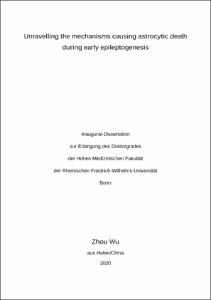Unravelling the mechanisms causing astrocytic death during early epileptogenesis

Unravelling the mechanisms causing astrocytic death during early epileptogenesis

| dc.contributor.advisor | Steinhäuser, Christian | |
| dc.contributor.author | Wu, Zhou | |
| dc.date.accessioned | 2020-05-28T09:03:35Z | |
| dc.date.available | 2020-05-28T09:03:35Z | |
| dc.date.issued | 28.05.2020 | |
| dc.identifier.uri | https://hdl.handle.net/20.500.11811/8384 | |
| dc.description.abstract | Epilepsy is a disorder of the brain characterised by unprovoked, recurrent seizures and affects about 1% of the population worldwide. A deeper understanding of the cellular mechanisms leading to epilepsy are essential for the identification of novel targets for therapeutic intervention. Growing evidence suggests that dysfunctional astrocytes are crucial players in the development of temporal lobe epilepsy (TLE). In a mouse model of TLE with hippocampal sclerosis (HS) we found a transient but significant reduction in the number of GFAP-positive astrocytes in the CA1 stratum radiatum (SR) of the ipsilateral hippocampus, starting 4 hours after kainate-induced status epilepticus. The goal of the present study was to elucidate molecular mechanism responsible for the astrocytic loss. For this purpose, we used immunohistochemical staining and semiquantitative RT-PCR analysis to identify marker of different cellular death mechanism 4 hours after epilepsy induction. We did not find any cleaved-caspase 3 or TUNEL positive astrocytes in the epileptic tissue, ruling out the involvement of apoptotic death. A contribution of autophagic cell death could also be excluded, since we observed only low/negligible expression of autophagy-related genes and proteins (lc3-a, b; lamp2, becn1, LC3-B). However, we found a significant increase of receptor interacting protein kinase 3 (RIPK3) and mixed lineage kinase domain-like protein (MLKL) positive astrocytes as well as enhanced expression of the corresponding necroptosis-related genes (ripk3 and mlkl) in the ipsilateral CA1 SR of kainate-injected mice. Moreover, using phospho-specific antibodies ipsilaterally we observed phosphorylation of MLKL (pMLKL) and the formation of necrosome complexes between RIPK3 and pMLKL in kainate-injected animals. Co-localization analysis showed translocation of pMLKL to the nucleus and the plasma membrane in astrocytes of the ipsilateral hippocampus. Taken together, the present study suggests that a considerable proportion of hippocampal astrocytes undergo necroptotic cell death during early epileptogenesis. | en |
| dc.language.iso | eng | |
| dc.rights | In Copyright | |
| dc.rights.uri | http://rightsstatements.org/vocab/InC/1.0/ | |
| dc.subject.ddc | 610 Medizin, Gesundheit | |
| dc.title | Unravelling the mechanisms causing astrocytic death during early epileptogenesis | |
| dc.type | Dissertation oder Habilitation | |
| dc.publisher.name | Universitäts- und Landesbibliothek Bonn | |
| dc.publisher.location | Bonn | |
| dc.rights.accessRights | openAccess | |
| dc.identifier.urn | https://nbn-resolving.org/urn:nbn:de:hbz:5-57110 | |
| ulbbn.pubtype | Erstveröffentlichung | |
| ulbbnediss.affiliation.name | Rheinische Friedrich-Wilhelms-Universität Bonn | |
| ulbbnediss.affiliation.location | Bonn | |
| ulbbnediss.thesis.level | Dissertation | |
| ulbbnediss.dissID | 5711 | |
| ulbbnediss.date.accepted | 12.12.2019 | |
| ulbbnediss.institute | Medizinische Fakultät / Institute : Institut für Zelluläre Neurowissenschaften (IZN) | |
| ulbbnediss.fakultaet | Medizinische Fakultät | |
| dc.contributor.coReferee | Schilling, Karl |
Dateien zu dieser Ressource
Das Dokument erscheint in:
-
E-Dissertationen (1706)




